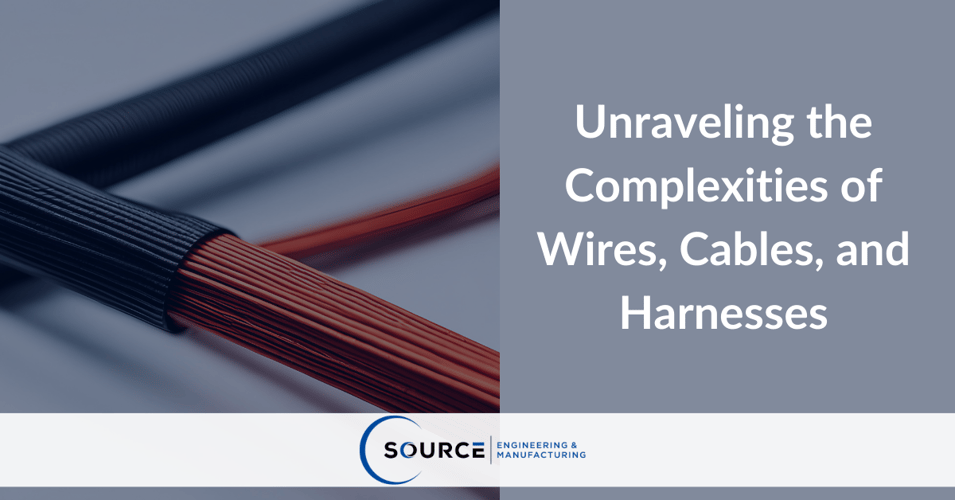
Table of Contents
In electrical and electronic manufacturing, understanding the nuances between seemingly similar components can be the difference between a well-executed project and one fraught with complications. This blog post aims to demystify the differences between wires, cables, and wire harnesses, offering insight into their distinct roles within various applications.

What is the difference between wire and cable and harness?
When navigating the electrical landscape, it's essential to distinguish between a wire, a cable, and a harness. Though often used interchangeably, each serves a unique purpose.
What is the difference between a wire and a cable?
Wire is a single conductor, typically made of copper or aluminum, that carries electric current. It is the foundation of all electrical systems, providing the pathway for electricity to flow.
Cable, on the other hand, consists of multiple wires bundled together under a single sheath. This design allows for transmitting multiple signals or currents simultaneously, making cables ideal for complex systems where space and organization are paramount.
Wire Harness refers to an assembly of wires and cables, often bound together by sleeves, cable ties, or conduits. Wire harnesses are designed to simplify the installation process and reduce the risk of errors, particularly in environments where numerous circuits must coexist.
Cable Harness, similar to a wire harness, is a sophisticated assembly of cables and wires meticulously organized to form a single unit. It is designed for more demanding environments where both electrical and mechanical protection are necessary. The primary purpose of a cable harness is to ensure optimal performance and reliability in complex machinery and large-scale electrical systems by providing a streamlined solution for power and signal distribution. Like wire harnesses, they are customized to fit specific applications, offering an efficient, safer, and more reliable means of connectivity compared to individual wires and cables.
By understanding these distinctions, engineers and technicians can make informed decisions about the materials and designs that will best serve their project's needs.
What is the difference between wire and wire harness?
While a wire is a single entity, a wire harness represents a higher level of complexity and organization.
A wire harness is effectively a structured grouping of multiple wires and sometimes cables, designed to streamline electrical systems by organizing them into a more manageable format. This organization is critical in minimizing the space used and reducing the chance of a malfunction, which can be caused by loose connections or tangled wires. Harnesses are instrumental in preventing shorts and simplifying the troubleshooting process, making them indispensable in complex installations like automobiles, aircraft, and industrial machinery. The design of a wire harness is meticulously planned to meet the precise specifications of the project, ensuring that each wire and cable is optimally placed for functionality, safety, and maintenance ease.
Furthermore, the custom nature of wire harnesses allows for a level of versatility and specificity that generic wires or cables cannot provide. Manufacturers work closely with clients to understand the unique requirements of their projects, tailoring each harness to fit the exact dimensions, electrical needs, and environmental conditions it will face. This collaborative approach not only improves the quality and performance of the electrical system but also contributes to greater efficiency during the assembly process. By reducing the potential for error and accommodating precise project demands, wire harnesses demonstrate a clear advantage in applications where reliability and precision are paramount.
Wiring Harness Materials: The choice of material for a wire harness is critical and depends on its intended use. Common materials include PVC, rubber, and thermoplastic elastomers, each selected for their durability, flexibility, and resistance to environmental factors like heat, moisture, and chemicals.
Wire Harness Manufacturers: Selecting a reputable manufacturer is vital. The best wire harness assembly companies boast extensive experience, adherence to industry standards, and a proven track record of reliability. Source Engineering & Manufacturing, established in 2001, exemplifies such expertise, with over 185 years of combined experience in producing high-quality custom cable assemblies, wire harnesses, and panel builds.
Uses in Electronics: Wire harnesses are widely used across various industries, including automotive, aerospace, and consumer electronics. They are pivotal in managing complex wiring systems and ensuring that electronic devices function seamlessly and safely.
Conclusion
Choosing the right component—be it a wire, a cable, or a harness—is crucial for the success of any project involving electrical circuits. Understanding the differences and applications of each can significantly impact the efficiency, safety, and reliability of your electrical systems.
For those looking to partner with one of the best wire harness assembly companies, Source Engineering & Manufacturing offers unparalleled expertise and quality service. Visit www.sourceeng.com to learn more about how we can assist with your custom cable assembly, wire harness, or panel build needs.




